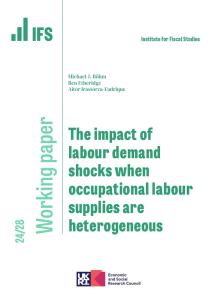Strong pay growth in finance and business services since the pandemic has benefited high earners in London, leading to a rise in geographical inequality in mean earnings. However, middle earners in London have seen little pay growth.
Post-pandemic growth in earnings has been strongest in business services
Pay growth since the start of the pandemic has been concentrated in energy and business services. This is shown in Figure 1, which plots the change in mean earnings adjusted for inflation between February 2020 and May 2023 using payroll data from HMRC.1 Outside the energy sector, the biggest pay rises were seen in administrative and support services (9.8%) and professional services (8.6%). Real earnings in finance have fallen since their peak in mid 2022, but are still 7.6% above their pre-pandemic level. Information and communications (ICT), another high-skilled service sector, also saw mean earnings rise, by 5.5%. In contrast, pay across the economy grew by only 2.7% over this period, with many sectors seeing declines of 1.0% to 3.9%.2
Business services are concentrated in London, which has seen the biggest rise in mean earnings …
Nearly a third (32%) of jobs in finance, professional services and ICT are based in London, which accounts for less than a fifth (18%) of all jobs across the economy.3 As a result, mean earnings growth among employees living in and around London has outstripped growth in the rest of the country, as shown in Figure 2. Mean earnings for employees living in London increased by 5.0% in real terms since the pandemic began, whilst many areas close to London – whose residents may also work in the capital – saw pay increases of over 4.5%.4
… implying a rise in geographical inequality in mean earnings
London and the surrounding counties already had high levels of earnings before the pandemic. The recent earnings growth in these areas has therefore exacerbated geographical inequalities in mean earnings, as shown in Figure 3. This reverses the trend of falling inequality in mean earnings across places in the two decades leading up to the pandemic.
But these trends are driven by top earners – middle earners in London are not seeing higher pay growth
However, the fact that mean earnings have increased most in London does not imply that everyone in London has had a big pay rise. First, employees working in the sectors seeing high pay growth tend to be towards the top of the pay distribution – for example, national mean earnings in finance are £7,500 a month before tax, and half of all finance workers are paid over £3,700 a month. Second, pay growth in business services sectors in London has been driven by the highest earners within these sectors. Mean pay in London is growing faster than median (middle) pay in finance, professional services, and administrative and support services.5 Third, median pay growth in some low-paid sectors – including hospitality, wholesale and retail, arts and leisure, and other services – has been slower in London than in other parts of the country.6
These factors together mean that, despite high growth in mean earnings, real median earnings have risen by only 1.7% since the pandemic began, to £2,700 a month before tax. That is, top earners in London have pulled away whilst middle earners have seen little real pay growth, leading to an increase in earnings inequality within London.
Figure 4 shows that a different pattern has been seen in most of the rest of the country. Most areas have seen higher growth in median earnings than in mean earnings, implying a fall in earnings inequality at the local level. This continues the trend towards greater pay equality locally in most places since 2014, when the PAYE data became available.
Summary
Since the pandemic, pay growth has been concentrated in business services sectors, which tend to be highly paid and located in and around London. This has increased inequalities in mean earnings across the country, reversing the trend of falling geographical inequality in mean earnings in the two decades leading up to the pandemic. However, middle earners in London have seen little real pay growth since the pandemic began. With the top pulling away and the middle seeing low growth, there has been an increase in earnings inequality within London.









